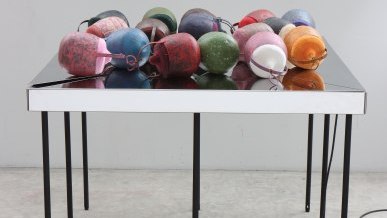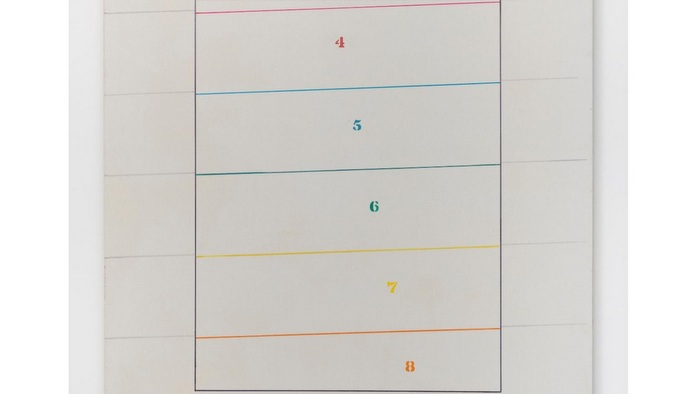Castelli Gallery's booth at The Art Show, ADAA is dedicated to artists Arakawa and Robert Morris. The two met in December 1961 in TriBeCa when Arakawa moved to New York. Upon his arrival, Arakawa first lived in Yoko Ono's loft at 112 Chamber's Street, a fixture in the New York art scene. Already living in the loft was Robert Morris. The artists formed a friendship and were influential in one another's careers.
On the occasion of The Art Show, we asked Professor Takashi Ikegami from the University of Tokyo to write about Arakawa's 42+, 1966, which will be included in the booth.
In Douglas Adams' The Hitchhiker's Guide to the Galaxy, we encounter the answer to the ultimate questions: "What is life?" and "What is the universe?" The response, yielded by the galaxy's most formidable computer after millennia of computation, is, astonishingly, "42."
Shusaku Arakawa and Madeline Gins, through their Mechanism of Meaning, have persistently posed myriad inquiries. Their paintings, and subsequently their "Reversible Destiny" architecture, probe the essence of life and human existence. Their aspirations align with those of artificial life, self-organization, and the sciences of complexity. Will their answer manifest as an intricate mathematical theory, an unprecedented robotic entity, or perhaps, simply as "42"?
Last year, at an Arakawa exhibition in Karuizawa, I encountered a work titled 42. The canvas displayed a sequence of numbers: 3/4/5/6/7/8/9, their sum equaling 42. One might surmise that Arakawa and Gins, post "Mechanism of Meaning," sought to elucidate this concept through architecture. With both having passed on, we are left to conjecture. I initially thought Arakawa's incorporation of "42," Adams' novelistic answer, was entirely fitting into his work.
However, a subsequent revelation astounded me: Arakawa’s work predated the publication of "The Hitchhiker's Guide to the Galaxy." Could Adams have drawn inspiration from this work? Which came first in this cosmic convergence of ideas?
While Adams' work, to my knowledge, lacks a sequel, Arakawa's piece, remarkably, has a continuation. Titled 42+, it was exhibited adjacent to "42." Nearly identical in layout to its predecessor, "42+" is subtly inclined, with the number 2 partially visible at the top. This consideration implies a sum exceeding 42.
Perhaps 42 is insufficient as an answer to "What is life?" Arakawa may have been in pursuit of this elusive surplus. I, too, count myself among the researchers exploring the realm of 42+. Yet, the fundamental question persists: from whence did 42 originate? Such contemplations have led me down this path of inquiry.
On the cover: Arakawa, 42+, 1966
Oil and marker on canvas
60 x 48 inches (152.4 x 121.9 centimeters)
© Reversible Destiny Foundation
Source: Castelli Gallery
Related Publications

Galerie Lelong & Co.: Pinaree Sanpitak
November 01, 2024
Fred Sandback: Threading Space
October 28, 2024












